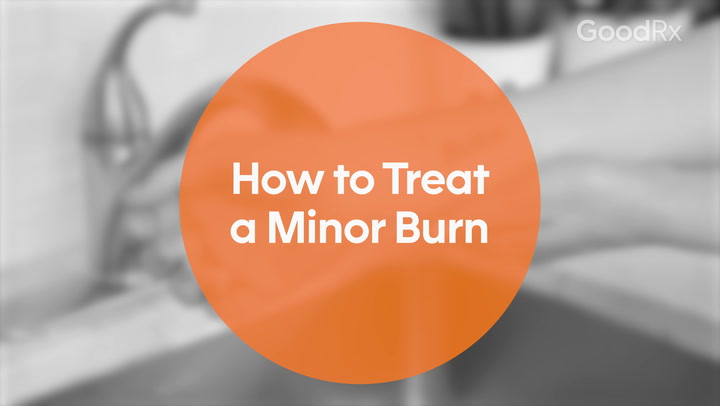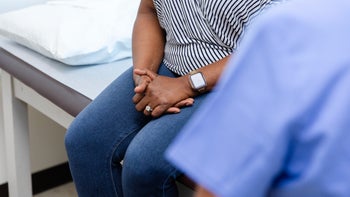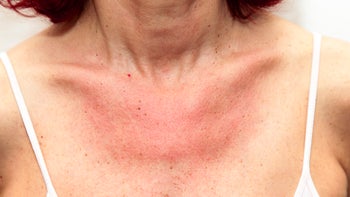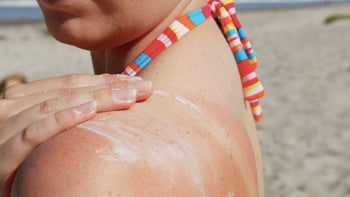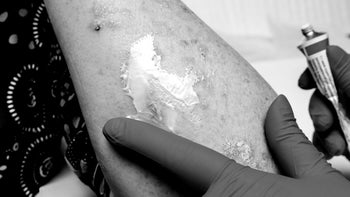
Sunburn vs. Sun Poisoning: How to Tell the Difference (With Pictures)
Key takeaways:
Sunburn is a reaction to the damaging ultraviolet (UV) rays of the sun. Sun poisoning is a severe sunburn.
While you can treat sunburns at home, sun poisoning may require medical attention.
Both sunburn and sun poisoning are preventable. You can protect your skin and eyes from the sun by using sunglasses, sunscreen, clothes, and a hat.
Table of contents
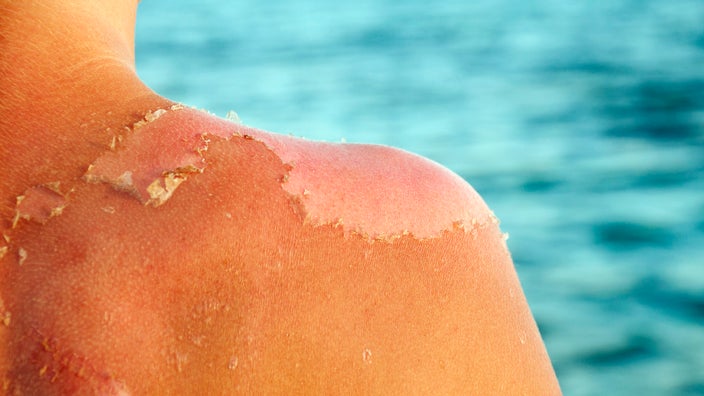
You’re likely familiar with the telltale symptoms of sunburn. Sunburn causes red, itchy, or tender areas of skin. You can end up with a sunburn even on a cloudy day.
Sun poisoning isn’t as common as sunburn, but it’s important to know how to tell the difference. Sun poisoning is a severe case of sunburn that can cause skin blistering, flu-like symptoms, and dehydration. If you have sun poisoning, you may need medical care.
So, how do you know if you have sun poisoning or a sunburn? Read on to learn the differences and see pictures of each.
Pay less for Retin-A
Save an average of over 40% off retail prices for Retin-A (tretinoin) when you use GoodRx, whether you have insurance or not.

Sunburn vs. sun poisoning symptoms
Damaging ultraviolet (UV) rays can affect each person differently and impact every exposed part of the body — even your eyes.
When the skin gets more UV exposure than it can handle, it causes inflammation. While the symptoms of sunburn are uncomfortable, they’re usually mild and treatable at home. If you get sun poisoning, it doesn’t actually mean that you were “poisoned” by the sun’s UV rays. It means that you have a serious sunburn.
Symptoms of sunburn start within minutes to hours of UV exposure from the sun or a tanning bed. Common skin changes with a sunburn include:
Redness
Itchiness
Sensitivity
Pain
Warmth
You’re more likely to have sun poisoning if you’ve been outside for a long time without sun protection. Sun poisoning may feel and look like a sunburn at first, but it has more serious symptoms.
You may have sun poisoning if you have:
Skin blistering
Skin rash
Severe swelling, redness, and pain
Fever and chills
Confusion
Dizziness or fainting
Nausea or vomiting
Medications can cause sunburn: From antibiotics to Aleve, these 12 common medications can make you more sensitive to the sun.
Sunburn increases your risk for skin cancer: Skin cancer is curable when it’s caught early. Learn what different skin cancers look like (with pictures).
How to prevent sunburn: Sunscreen isn’t your only option. Learn five other effective ways to protect your skin from the sun.
Sun poisoning can be mistaken for the flu or an allergic reaction to something. If you aren’t certain what you’re experiencing, get medical care. Sun poisoning is serious. In fact, there are more than 33,000 emergency room visits because of sunburns every year.
Sun poisoning can be particularly dangerous for a baby or young child. Call your pediatrician or get medical care if your child develops any of the symptoms above.
Sunburn vs. sun poisoning pictures
Here’s a side-by-side visual comparison of sunburn versus sun poisoning.
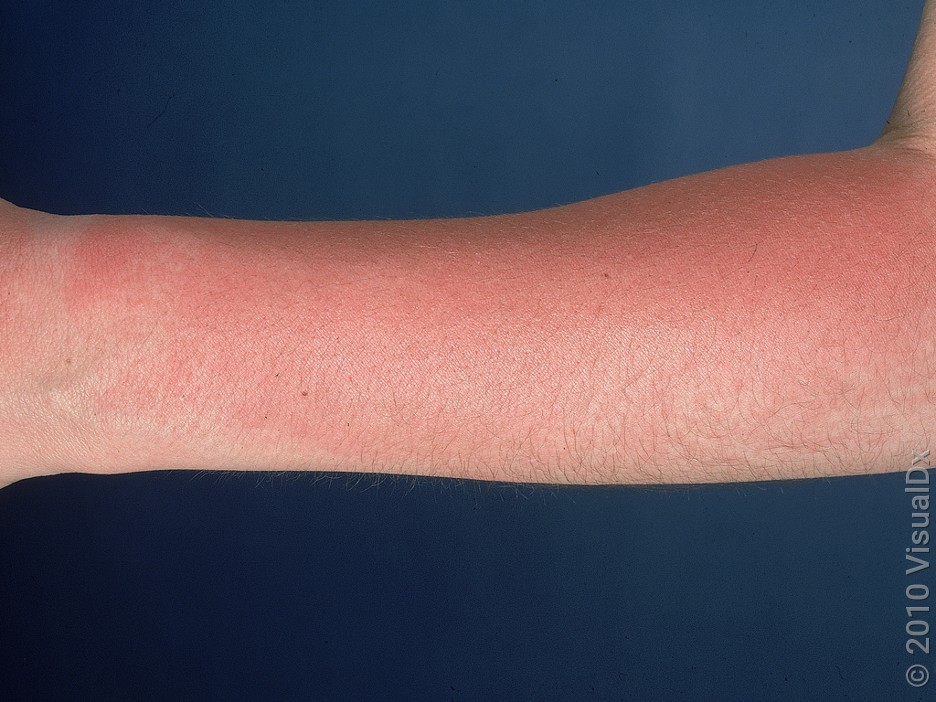
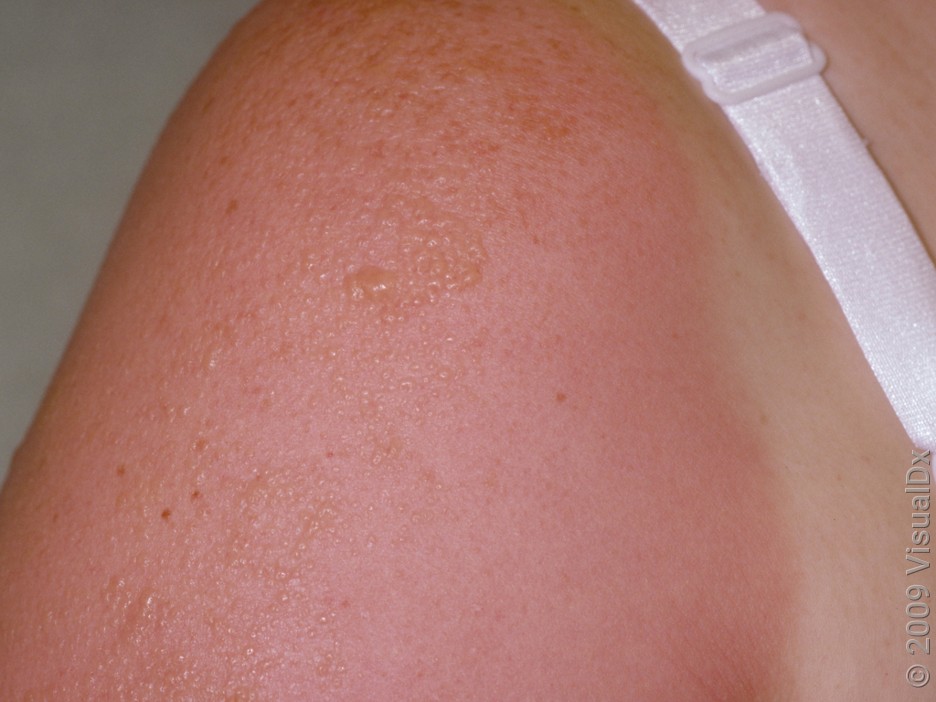
Sunburn vs. sun poisoning risks
Anyone can get a sunburn. But some things can increase your risk of developing it, including:
Taking certain medications, like some antibiotics, antidepressants, and diabetes medications
Having medical conditions, including autoimmune diseases like lupus, rheumatoid arthritis, and psoriasis
Having a lighter skin tone and light-colored eyes
Living in a geographic region with higher altitude or close to the equator
While people with lighter skin tones are at higher risk for sunburn and skin cancer, people with darker skin tones are at risk, too.
Read more like this
Explore these related articles, suggested for readers like you.
How do I prevent sunburn?
Getting sunburned at any time in the past raises your risk of skin cancer. This shows that even after sunburn symptoms go away, long-lasting effects of sun damage remain.
Skin cancer is the most common cancer in the U.S. — 1 out of every 5 people in the U.S. will be diagnosed with it in their lifetime.
Thankfully, sunburn, sun poisoning, and skin cancer are preventable conditions.
To lower your risk for sunburn:
Avoid the sun between 10 a.m. and 2 p.m.
Cover exposed skin with a hat, shirt, pants, and sunglasses.
Apply broad-spectrum, waterproof sunscreen with SPF 30 or higher every day. Apply sunscreen about 15 minutes before going outside, and reapply it every 2 hours.
Be aware of the reflection of UV rays off water or snow.
Stay out of tanning beds.
Sunburn vs. sun poisoning treatment
Whether you’re dealing with sunburn or sun poisoning, it’s important to act quickly. Here’s how to treat sunburn and sun poisoning.
Treatment for sunburn
Take the following steps to treat sunburn discomfort as soon as you can:
Find shade, ideally indoors.
Cool the skin with a moist compress, bath, or shower.
Moisturize damp skin with aloe vera or soy-based lotion.
Lower inflammation with over-the-counter (OTC) medications such as ibuprofen.
Drink water.
Allow skin blisters to heal on their own. Don’t try to pop them.
Wear protective clothing to cover sunburned skin while it heals.
Treatment for sun poisoning
While you can treat mild sunburn symptoms (redness, pain, swelling) at home, sun poisoning may need professional medical attention and treatment. Get medical care right away if you experience:
Severe blistering
Nausea or vomiting
Headache
Confusion
Fever
Treatment for sun poisoning will depend on how severe your symptoms are. Sun poisoning treatment may include:
Intravenous (IV) fluids for dehydration
Medications for inflammation and pain
Antibiotics to prevent infection
If your skin starts to blister, put a cold, damp cloth on the area. But don’t pick them or pop them. Blisters help the skin to heal. Opening blisters can raise your risk for infection and skin scarring.
While your skin is healing, avoid direct sun exposure and alcohol, stay well hydrated, and wear loose, comfortable clothing.
How long do sunburn and sun poisoning take to heal?
Sunburn symptoms will improve with time. But the recovery time will vary from person to person and depend on the severity of your burn.
A sunburn will typically:
Start within 4 hours of sun exposure
Worsen in the next 24 to 36 hours
Last for about 3 to 5 days
The recovery process from sun poisoning is longer. Pain typically lasts up to 48 hours, and skin will usually start to peel after 3 to 8 days. With a severe, blistering burn, your skin may not return to normal for several weeks.
When to see a healthcare professional
Get medical care right away if you have a sunburn and develop any of the following symptoms:
Nausea
Vomiting
Headache
Confusion
Fever
These could be signs of sun poisoning.
You should also check in with a healthcare professional if you develop severe or widespread blistering. They will help make sure your skin heals well and that you don’t develop a secondary skin infection.
Frequently asked questions
If you develop sun poisoning, the first step to quicker healing is to cool the skin with a cool compress, bath, or shower. You can also add oatmeal to the bath and use aloe vera gel or hydrocortisone cream to help soothe skin. For pain, discomfort, or swelling, a pain reliever like ibuprofen can help. Remember to drink plenty of water to stay hydrated.
Yes. It’s possible to get sun poisoning even if you’ve used sunscreen. This can happen if your sunscreen SPF isn’t high enough, if it’s expired, or if you haven’t reapplied it every 2 hours. Some medications that make you more sensitive to the sun (like doxycycline) can also increase your risk of getting sun poisoning even with sunscreen.
Your skin is a barrier that keeps bacteria out of your body and keeps water inside it. When your skin barrier is disrupted with a sunburn, you can lose lots of water and become dehydrated. If you have sun poisoning, drink plenty of water to help prevent dehydration. Drinking enough water when you’re in the sun is also a good idea because it can help prevent heat exhaustion and heatstroke.
Calamine lotion and a lightweight moisturizer with aloe vera or soy can help soothe sunburned skin. Apply them while your skin is still damp after taking a cool bath. You can also apply these throughout the day when your skin feels uncomfortable.
The bottom line
A sunburn is red, itchy, or tender skin that results from unprotected exposure to the sun. Sun poisoning may feel like a sunburn at first, but it’s more serious. While sunburn can be treated at home, sun poisoning may need medical treatment. Both can raise your risk for skin damage and cancer, so be sure to take steps to protect yourself from the sun.
Why trust our experts?



References
American Academy of Dermatology Association. (2024). Practice safe sun.
American Academy of Dermatology Association. (2025). Skin cancer.
American Academy of Dermatology Association. (2025). Sunscreen FAQs.
Cancer Trends Progress Report. (2025). Sunburn. National Cancer Institute.
Dennis, L. K., et al. (2008). Sunburns and risk of cutaneous melanoma, does age matter: A comprehensive meta-analysis. Annals of Epidemiology.
Ludmann, P., et al. (2024). How to treat sunburn. American Academy of Dermatology Association.
National Institute for Occupational Safety and Health. (2024). Sun exposure at work. Centers for Disease Control and Prevention.
Skin Cancer Foundation. (2023). Diseases related to abnormal photosensitivity responses of the skin.






